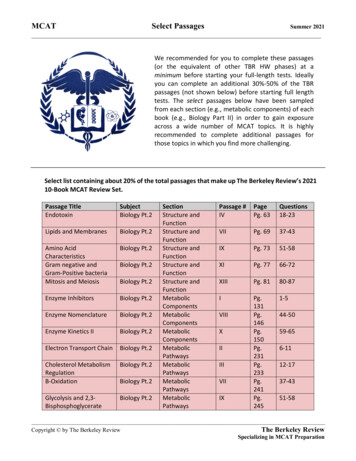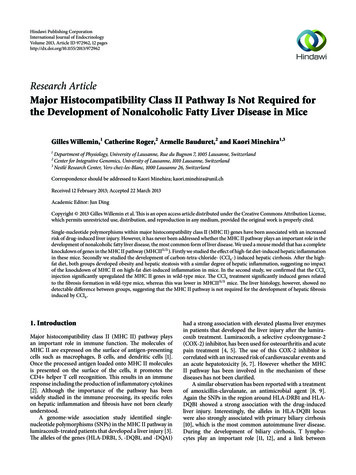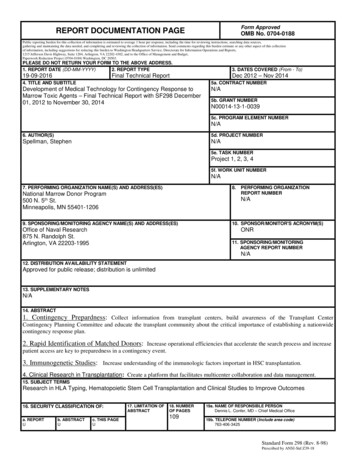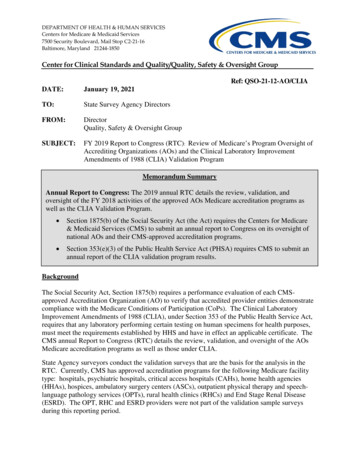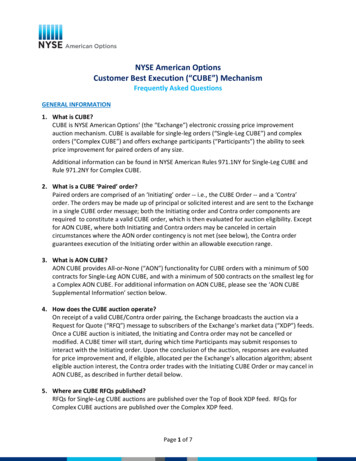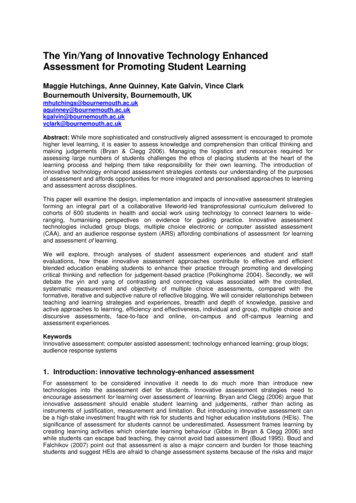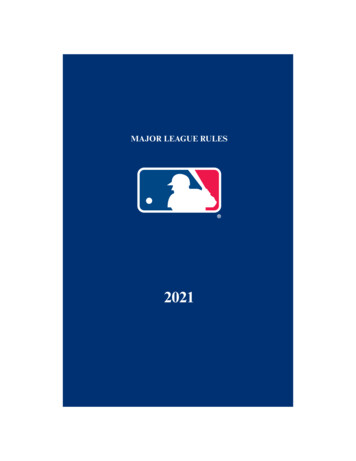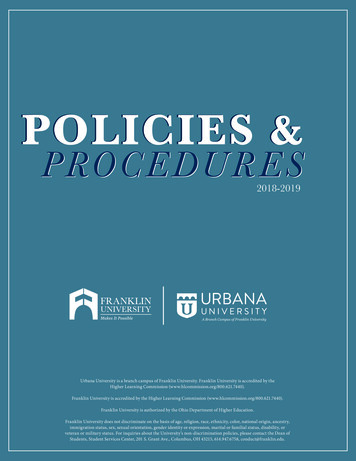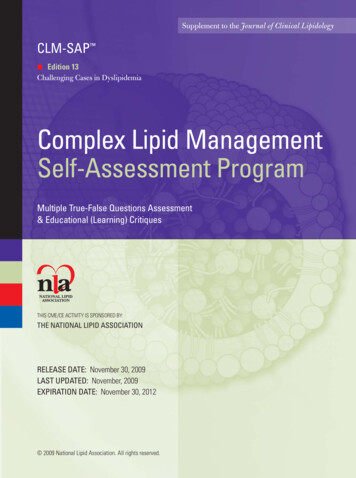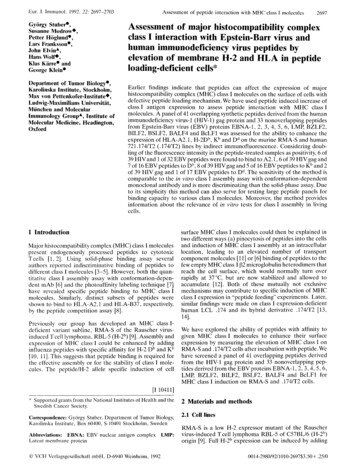
Transcription
Eur. J. Immunol. 1992. 22: 2697-2703Gyorgy Stuber.,Susanne Modrow ,Petter Hoglund.,Lars Franksson.,John ElvinA,Hans W o l e ,Klas Karre. andGeorge Klein.Department of Tumor Biology.,Karolinska Institute, Stockholm,Max yon Pettenkofer-Institute ,Ludwig-MaximiliansUniversitat,Munchen and MolecularImmunology GroupA, Institute ofMolecular Medicine, Headington,OxfordAssessment of peptide interaction with MHC class I molecules2697Assessment of major histocompatibility complexclass I interaction with Epstein-Barr virus andhuman immunodeficiency virus peptides byelevation of membrane H-2 and HLA in peptideloading-deficient cells*Earlier findings indicate that peptides can affect the expression of majorhistocompatibility complex (MHC) class I molecules on the surface of cells withdefective peptide loading mechanism. We have used peptide induced increase ofclass I antigen expression to assess peptide interaction with MHC class Imolecules. A panel of 41 overlapping synthetic peptides derived from the humanimmunodeficiency virus-1 (HIV-1) gag protein and 33 nonoverlapping peptidesfrom Epstein-Barr virus (EBV) proteins EBNA-1, 2, 3, 4, 5 , 6, LMP, BZLF2,BILF2, BSLF2, BALF4 and BcLFl was assessed for the ability to enhance theexpression of HLA-A2.1, H-2Db, Kh and Dd on the murine RMA-S and human721.174/T2 (.174/T2) lines by indirect immunofluorescence. Considering doubling of the fluorescence intensity in the peptide-treated samples as positivity, 6 of39 HIVand 1of 32 EBVpeptides were found to bind to A2.1,6 of 39 HIVgag and7 of 16 EBVpeptides to Dh,8 of 39 HIVgag and 5 of 16 EBV peptides to Kb and 2of 39 HIV gag and 1of 17 EBV peptides to Dd.The sensitivity of the method iscomparable to the in vitro class I assembly assay with conformation-dependentmonoclonal antibody and is more discriminating than the solid-phase assay. Dueto its simplicity this method can also serve for testing large peptide panels forbinding capacity to various class I molecules. Moreover, the method providesinformation about the relevance of in vitro tests for class I assembly in livingcells.1 IntroductionMajor histocompatibility complex (MHC) class I moleculespresent endogenously processed peptides to cytotoxicT cells [ 1, 21. Using solid-phase binding assay severalauthors reported indiscriminative binding of peptides todifferent class I moleculeo [3-51. However, both the quantitative class I assembly assay with conformation-dependent mAh [6] and the photoaffinity labeling technique [7]have revealed specific peptide binding to MHC class Imolecules. Similarly, distinct subsets of peptides wereshown to bind to HLA-A2.1 and HLA-B37, respectively,by the peptide competition assay [8].Previously our group has developed an MHC class Ideficient variant subline, RMA-S of the Rauscher virusinduced T cell lymphoma, RBL-5 (H-2”) [9]. Assembly andexpression of MHC class I could be enhanced by addinginfluenza peptides with specific affinity for H-2 Db and Kh(10, 111. This suggests that peptide binding is required forthe effective assembly or for the stability of class I molecules. The peptide/H-2 allele specific induction of cellsurface MHC class I molecules could then be explained intwo different ways (a) pinocytosis of peptides into the cellsand induction of MHC class I assembly at an intracellularlocation, leading to an elevated number of transportcomponent molecules [ l l ] or [6] binding of peptides to thefew empty MHC class I 62 microglobulin heterodimers thatreach the cell surface, which would normally turn overrapidly at 37”C, but are now stabilized and allowed toaccumulate [12]. Both of these mutually not exclusivemechanisms may contribute to specific induction of MHCclass I expression in “peptide feeding” experiments. Later,similar findings were made on class I expression-deficienthuman LCL .174 and its hybrid derivative .174/T2 [13,141.We have explored the ability of peptides with affinity togiven MHC class I molecules to enhance their surfaceexpression by measuring the elevation of MHC class I onRMA-S and .174/T2cells after incubation with peptide.Wehave screened a panel of 41 overlapping peptides derivedfrom the HIV-1 gag protein and 33 nonoverlapping peptides derived from the EBVproteins EBNA-1,2,3,4,5,6,LMP, BZLF2, BILF2, BSLF2, BALF4 and BcLFl forMHC class I induction on RMA-S and .174/T2 cells.[I 104111Supported grants from the National Institutes of Health and theSwedish Cancer Society.Correspondence: Gyorgy Stuber, Department of Tumor Biology,Karolinska Institute, Box 60400, S-10401 Stockholm, SwedenAbbreviations: EBNA: EBV nuclear antigen complexLatciit membrane proteinLMP:0 VCH Verlagsgesellschaft mbH. D-6940 Weinheim, 19922 Materials and methods2.1 Cell linesRMA-S is a low H-2 expressor mutant of the Rauschervirus-induced T cell lymphoma RBL-5 of C57BL/6 (H-2h)origin [9]. Full H-2” expression can be induced by adding0014-2980/92/1010-2697 3.50 .25/0
2698G. Stuber. S. Modrow, I? Hiiglund et a1H-2h affine peptides or incubating the cells at low temperature [lo-121. It is resistant to CTL specific for internallyprocessed antigens 1151. The antigen-processing defectcould be corrected by the transfection of the ATPdependent transport protein gene HAM-2 into the RMA-Scells [16].The H-2 Dd gene, when transfected into RMA-Scells was subject to the same peptide loading defect as theendogenous H-2hmolecule, and could be up-regulated byappropriate peptides or low temperature in a similar way(Franksson et al., to be published).The .174/T2 hybrid linewas kindly provided by Dr. P. Cresswell, Howard HughesMedical Institute, Section of Immunobiology,Yale University School of Medicine, New Haven, CT. It was derived byfusion of the .174 mutant LCL and the CEMRT lymphomaand selected for the loss of chromosome 6 of CEMR asdescribed [17-211. It does not express B5 and its HLA-A2.1expression is about 70%-80% lower than that of thewild-type LCL 721. Its peptide loading deficiency is mostprobably due to the deletion of the RING4 and RING11genes [22].2.2 Indirect immunoflnorescence assay for MHC-peptideinteraction and monoclonal antibodiesAliquots of 2.5 x los RMA-S or .174/T2 cells wereincubated with peptide in 250 pl RPMI 1640 for 24 h at37 C. The final peptide concentration was 100 p MHC.c l a s 1 levels were detected by indirect immunofluorescence using FACS IV (Becton Dickinson, Mountain View,CA). The results were calculated on the basis of fluorescence intensity (FI), FIvalnplc: FIcontrol,where sample meanspeptide-treated cells and control means cells withoutpeptide.Living cells were stained for MHC class I antigens byindirect immunotluorescence. The first layer was the 2814-8s (anti H-2 Db,mouse I g G p 1231, the 28-13-3s anti Kb,mouse IgM [24], the 34-5-8santi H-2 Dd,mouse IgGz,x 1251or the BB7.2 anti HLA-A2 a1 domain, mouse IgGzb [26].All the reagents were culture supernatants of hybridomasobtained from American Type Culture Collection (Rockville, MD), used at 10-15 pg/ml. The second layer was afluorescein isothiocyanate (F1TC)-labeled affinity-purifiedrabbit anti-mouse antibody (Sigma, Saint Louis, MO) at a1 : 20 dilution. Samples were analyzed by cytofluorimetryusing a fluorescence-activated cell sorter (FACS IV, BectonDickinson).Eur. J. Immunol. 1992. 22: 2697-2703peptides derived from EBNA-3 (aa334-346 and 339-352)have been identified as human T cell epitopes in advance1271.HIV-1 gag and EBNA-1 C term., EBNA-2a, EBNA3/EBV.1, EBNA2-EBV.2, Lydma-l,4, and 5 and the EBVlytic cycle protein peptides (Table 2) were synthesized witha 9050 Pepsynthesizer (Milligen. Eschborn, FRG) usingFmoc (9-fluorenylmethyloxycarbonyl)-protected aminoacids as described earlier 128, 291. The peptides werelyophylized and purified by reverse-phase high-performance liquid chromatography (HPLC) using a C2/C18copolymer column (Peps, Pharmacia, Freiburg, FRG) anda gradient of 0%-70% acetonitrileF in 0.1% trifluoroaceticacid. The peptide containing fractions were lyophilized andcharacterized by amino acid sequencing (Applied Biosystems, Weiterstedt, FRG). Peptides 68, 68b, 77 and KEHVIQNAFRK, kindly provided by Dr. D. Moss, QueenslandInstitute of Medical Research, Brisbane, Australia, weresynthesized as described earlier 1301. The remaining EBVpeptides were synthesized using t-Boc amino acids (Bachem, Bubendorf, Switzerland) and p-methylbenzhydrylamine resin (Fluka, Buchs, Switzerland) according to themultiple solid-phase peptide synthesis method as describedearlier 130-321 kindly provided by Dr. J. Dillner, Dept. ofVirology, Karolinska Institute, Stockholm, Sweden.2.4 MediumRPMI 1640 medium with L-glutamine (200 mM solution,1%by volume), benzylpenicillin (100 IU/ml), streptomycinsulfate (100 pg/ml), Hepes buffer (0.1 mM) and 10%heat-inactivated FCS was used for cell culturing.3 Results3.1 HIV-1 gag peptides affecting HLA-A2.1 expressionon .174/T2 cellsPeptides which caused elevation of MHC class I fluorescence intensity (FI) by a factor of 2 or more, calculated withthe formula given in Sect. 2.2, were considered as positive.We detected 6/39 positive peptides on HLA-A2.1. Thequantified cytofluorimetric results are shown inTable 1andFig. l a .2.3 Peptide synthesisA series of 41 peptides spanning the HIV-1 gag polyproteinprecursor molecule were synthesized. The peptides are 24amino acids (aa) long (with the exception of the 22-23 aalong peptides 1,14,15,17 and 25 aa long peptide 27 and 30)ovcrlap in 12 (in some cases 11 or 13) aa with bothneighboring peptides (Table 1). In addition, 33 peptidesderived from the EBV-encoded proteins EBNA-1,2, 3, 4,5, 6, LMP, BZLF2, BILF2, BSLF2, BALF4 and BcLFlLMP (Table2) were synthesized. The majority of thepeptides derived from EBV-encoded proteins were originally synthesized in order to produce monospecific antipeptide sera to identify the corresponding EBV geneproducts in Western blots or similar immunoassays. The3.2 HIV-1 gag peptides affecting H-2 Dh, Kb or Dbexpression on RMA-S cellsOf39 peptides 6 elevated the expression of Dbmolecules onRMA-S cells by a factor of two or more (Table 1 andFig. 1b). None of these positive peptides was identical oroverlapping with those elevating the A2.1 levels on the.174/T2 line. Of 39 peptides 8 were found positive on Kb(Table 1, Fig. 1c). Three of these, gag 14, 21 and 22 werepositive on the HLA-A2.1 as well and one, gag 12 waspositive also for Db and Dd. It is noteworthy that the latterpeptide appeared to be cross-reactive with all the fourMHC class I antigens as it was on the borderline ofpositivity (1.8) also for A2.1.
Eur. J. lmmunol. 1992. 22: 2697-2703Assessment of peptide interaction with MHC class I molecules2699We found 2 of 39 peptides that elevated Dd expression atleast with factor 2 (Tdble I). One of these, gag 27 enhancedthe expression of the Dd molecule with a factor of 2.9 butdid not affect the other two murine MHC molecules at alland elevated only weakly the expression of the A2.1molecules (1.4).lo) HLA 2.1 binding peptides3.3 Sensitivity of the method as compared with othertechniquesMGARASVLSG GELDRWEKIR LRPGGKKKYK LKHIVWASRE LERFAVNPGLf.f.LETSEGCRQI LGQLQPSLQT GSEELRSLYN TVATLYCVHQ RIEIKDTKEAI'-I**LDKIEEEQNK SKKKAQQAAA DTGHSSQVSQ NYPlVQNlQG QMVHQAISPRf.TLNAWVKWE EKAFSPEVIP MFSALSEGAT PQDLNTMLNT VGGHQAAM-f *QMLKETINEEAA EWDRVHPVHA GPIAPGQMRE PRGSDIAGT S T Z Gff*.WMTNNPPIPVGE IYKRWIILGL NKlVRMYSPT SILDIRQGPK EPFRDWDRFWe have found that 15%, 21% and 15% of 39 HTV-1 gagpeptides were positive on Db,Kh and A2.1, respectively, asdetected by immunofluorescence. Using a quantitativeassembly assay (immunoprecipitation with conformationdependent mAb), Elvin et al. [6] found that 22%, 15% and14% of 49 HIV-1 gag peptides (of 15 aa average length,showing a 5 aa overlap with the neighboring ones) gavepositive signals on Db, Kb and A2.1, respectively. Thissuggests that the sensitivities of the two methods aresimilar, and that they are more discriminative than thesolid-phase plate binding assay which suggested that 44%of the HIV-1 gag peptides, identical to those used by Elvinet al., bound to A2.1 [4].YKTLRAEQAS QEVKNWMTET LLVQNANPDC KTILKALGPA ATLEEMMTIcl H-2 Kb' binding peptidesAC QGVGGPGHKA RVLAEMSQV TNTATIMMQR GNFRNQRKMV KCFNCGKEGH TARNCRAPRK KGCWKCGKEG HQMKDCTERQ A N F VLSG GELDRWEKIR LRPGGKKKYK LKHIWASRE LERFAVNPGLLETSEQCRQI LGQLQPSLQT GSEELRSLYN TVATLYCVHQ RIEIKDTKEALDKIEEEQNK SKKKAQQAAA DTGHSSQVSQ NYPIVQNIQG QMYHQAISP?--T'ITPPQKQEP IDKECYPLTS LRSLFGNDPS SQ-1(bl-TLNAWVKWE EKAFSPEVIP MFSALSEGAT PQDLNTMLNT VGGHQAAMQM LKETINEEAA EWDRVHPVHA GPIAPGQMRE PRGSDlAGm S T E QH-2 Db binding peptidesMGARASVLSG GELDRWEKIR LRPGGKKKYK LKHIWASRE LERFAVNPGL.IGWM TNNPPIPVGE IWKRWllLGL NKIVRMYSPT SILDIRQGPK EPFRDWDLETSEGCRQIp a l OPSl OT GSFFt RSLYN TVATLYCVHQ RIEIKDTKEAr1RF YKTLRAEQAS QEVKNWMTET LLVQNANPDC KTILKALGPA ATLEEMMLDKIEEEQNK SKKKAQQAAA DTGHSSQVSQ NYPIVQNIQG QMyHQAlSPq-TAC QGVGGPGHKA RVLAEMSQV TNTATIMMQR GNFRNQRKMV KCFNCGTLNAWVIC/VE EKAFSPEVIP MFSALSEGAT PQDLNTMLNT VGPHQAAM,KEGH TARNCRAPRK KGCWKCGKEG HQMKDCTERQ ANFLGKIWPS YKG.QM LKETINEEAA EWDRVHPVHA GPIAPGQMRE PRGSDIAGlT QKQEPWM TNNPPIPVGE IYKRWllLGL NKIVRMYSPT SILDIRQGPK EPFRDWDRFIDKELYPLTS LRSLFGNDPS SQYKTLRAEQAS QEVKNWMTET LLVQNANPDC KTILKALGPA ATLEEMMTACQGVGGPGHKA RVLAEMSQV TNTATIMMQR GNFRNQRKMV KCFNCGKE-5 TARNCRAPRK KGCWKCGKEG HQMKDCTERQ ANFLGKIWPS YKGRPGNFLQ SRPEPTAPPF LQSRPEPTAP PEESFRSGVE TTPPQKQEP IDKE-LYPLTS LRSLFGNDPS SQFigure 1. Ability of overlapping synthetic peptides to enhanceexpression ol MHC class I molecules. (a) HLA-A2.1; (b) H-2 Dh;(c) Kb, assessed by indirect immunofluorescence (solid symbolsabove the sequence) and by the in vitro assembly assay [6] (opensymbols below the sequence). Peptides which caused elevation ofMHC class I fluorescence intensity (FI) by a factor of 2 or more.calculated with the formula given in Sect. 2.2 and peptidcsincreasing thc concentration of the folded heavy chains more thanthree standard deviations from the control were considered aspositive in the immunofluorescence and in vitvo assembly assays,respectively. Bold letters mark motifs of peptides binding to therelevant MHC class I molecules, predicted by computer searchingbased on published motifs [33].Asterisks mark the first amino acidof the motifs.
2700G . Stubcr. S. Modrow, F! Hiiglund et al.Eur. J. lmmunol. 1992. 22: 2697-27033.4 EBV peptides affecting HLA-A2.1 expression onthe .174/T2 cellsThirty-two peptides derived from EBV-associated proteinswcre screened for the capacity to interact with HLA-A2.1.One of them, the EBNA-1-derived peptide 107 elevatedthe expression of HLA-A2.1 molecules by more than factor2 (Table 2).3.5 EBV peptides affecting H-2 Db, Kb or Dd expressionon RMA-S cellsOf the 16 screened peptides 7 were found positive forinduction of lS'expression. One of them was derived fromEBNA-2, 4 from EBNA-3, 1 from EBNA-6 and 1 derivedfrom LMP (Table 2). Five of them elevated the expressionof Kb as well, but had no effect on A2.1 and Dd. Of 16peptides screened on Kb 5 were positive. One was derivedfrom EBNA-2,3 from EBNA-3 and 1from EBNA-6. Theyelevated also Dh expression, but had no effect on A2.1 andDd (Table 2). Seventeen peptides were also tested on theRMA-S Dd transfectant. One, BSLF2 1-13 was positivewithout cross-reactivity for the other included class Iantigens (Table 2).3.6 Comparison of the positive peptides with motifs forthe respective MHC class 1 moleculesWe made a computer searching for A2.1, Db and Kbbindingnonamers in the HIV-1 gag protein based on the publishedTable 1. Effect of overlapping peptides spanning the HIV-1 gag protein on the expression of MHC class I molecules on cells of the peptideloading dcficient human .174/T2 (HLA-A2.1) line, murine RMA-S line (H-2 Dh and Kh) and its transfectant with the Dd genePeptideMHC class I expressionA2.1DKbDd1 MGARASVLSGGELDRWEKIRLR2 ELDRWEKIRLRPGGKKKYKLKHIV3 PGGKKKYKLKHIVWASRELERFAV1 WASRELERFAVNPGLLETSEGCRQ5 NPGLLETSEGCRQILGQLQPSLQT6 ILGQLQPSLQTGSEELRSLYNTVA7 SEELRSLYNTVATLYCVHQRIEIK8 LYCVHQRIEIKDTKEALDKIEEEQ9 TKEALDKIEEEQNKSKKKAAAA10 NKSKKKAQQAA ADTGHSSQVSQNY11 TGHSSQVSQNYPIVQNIQGQMVHQ12 PIVQNIQGQMWHQAISPRTLNAWVK13 AISPRTLNAWVKVVEEKAFSPEVI14 VVEEKAFSPEVIPMFSALSEGAT15 MFSALSEGATPQDLNTMLNTVGG16 PQDLNTMLNTVGGHQAAMQMLKET17 HQAAMQMLKETINEEAAEWDRVH18 INEEAAEWDRVHPVHAGPIAPGQM19 PVHAGPIAPGQMREPRGSDIAGTT20 FEPRGSDIAGTTSTLQEQIGWMTN21 STLQEQIGWMTNNPPIPVGEIYKR22 NPPIPVGEIYKRWIILGLNKIVRM23 WIILGLNKIVRMYSPTSILDIRQG24 YSPTSILDIRQGPKEPFRDYVDRF25 PKEPFRDY VDRFYKTLRAEQASQE26 YKTLRAEQASQEVKN WMTETLLVQ27 KNWMTETLLVQNANPDCKTILKALG28 ANPDCKTILKALGPAATLEEMMTA29 AATLEEMMTACQGVGGPGHKARVL30 GVGGPGHKARVLAEAMSQVTNTAT31 AEMSQVTNTATIMMQRGNFRNQR32 MMQRGNFRNQRKMVKCFNCGKEGH33 MVKCFNCGKEGHTARNCRAPRKKG34 TARNCRAPRKKGCWKCGKEGHQMK35 WKCGKEGHQMKDCTERQANFLKGI36 CTERQANFLGKI WPSYKGRPGNFL37 PSYKGRPGNFLQSRPEPTAPPELQ38 SRPEPTAPPFLQSRPEPTAPPEES39 RPEPTAPPEESFRSGVETTTPPQK40 RSGVETITPPQKQEPIDKELYPLT41 EPIDKELYPLTSLRSLFGNDPSSQMP 57-68 K62 KGILGKVFTLTV"NP 345-360 SFIRGTKVSPRGKLS'P)NP 365-279 IASNENMDAMESSTLe)I 91.01.51.10.91.21 .8a) The results were calculated on thebasis of fluorescence intensity (FI):where sample means peptideFICOlltrOltreated cells and control means cellswithout peptide.Peptides which elevated the fluorescence intensity with a factor of 2 ormore were classed as positives (underlined).Influenza matrix protein peptide K62,included as control for HLA-A2.1binding.Influenza nucleoprotein peptide. control for Kh binding.Influenza nucleoprotein peptide, control for D" binding.Frsarnp'cb)c)d)e)
Eur. J. Immunol. 1992. 22: 2697-2703Assessment of peptide interaction with MHC class 1 moleculesmotifs for these allele products [33]. Thirty-one A2.1binding motifs were found, distributed in 23 peptides in ourHIV-1 gag peptide panel (Fig. 1a). Two of the six peptideswhich elevated A2.1 expression with factor 2 or moreincluded such motifs. Of the 23 peptides includingmotif(s)l4 (61%) caused elevation of A2.1 expression witha factor of 1.5 or more. O n the other hand 6 of the 16peptides (38%) without motif elevated A2.1 expression 1.52701or more.The finding that both the overlapping HIV-1 gag11and 12 peptides elevated A2.1, could be explained by therelevant motif included into the overlapping part of theboth peptides.Six Db binding motifs were predicted in the HIV-1 gagprotein distributed in 5 peptides in our panel (Fig. 1b).One of the 6 peptides in our panel, which elevated DbTable 2. Effect of peptides derived from EBV-encoded proteins on the expression of MHC class I molecules on cells of the deficienthuman .174/T2 (HLA-A2.1) line, murine RMA-S line (H-2 Db and Kh) and its Dd transfectantMHC class I expressionA2.1 DbKdDdPeptideLatent ProteinsEBNA-1EBNA-1C-term107108EBNA-1, 5EBNA-1, GRGEKRPRSPSSQSSSS1.4") LDESWDYEFETT1.01.21.5AWN NAFRKEENLLDFVRFMGVMSSCNNP0.7--77LMPLydma-1 (42-53C)405 (43-53)Lydma-4 (125-132)Lydma-S (159-171)TB2 (321-331)TB2a (321-331)1-18138 21.21.01.21.0--1.01.o2.00.91.0116 (213-23OC)TB3 (305-317)TBl (454-465)EBNA-368B68GEBNA3EBV. 1(334-348)EBNA-3lEBV.2(339-353)5.52.01.7 0.92.3--EBNA-6Proteins of the lytic cycleBcLFl (327-352)VMRTFGEHMARIVDSPEICAGSTKSDLBILF2 (K4, 48-69)VSRIELGRGYTPCBZLFl 2. exonLEIKRYKNRVASKCBSLF2 (1-13)HVPSQLRSRTSSLBALF4 (266-278)GTNPQGERRATLDCBALF4 (675-688)RKDLDN AVSNGRNQC1.5- 4 . 1 %-0.90.71.5-0.9--a) Results were calculated as in Table 1.b) -: not tested.
2702G. Stubcr, S. Modrow, P. Hoglund ct al.expression with a factor 2 or more included two such motifs.Of the 5 peptides 2 (400/) which included motif(s) and 8 ofthe 34 peptides (24%) without motif(s) elevated Dhexpression more than 1.5 times.Four K”-binding motifs were predicted, distributed in 4peptides in our panel (Fig. 1 c). Of the 8 peptides positive inour assessment 1 included Kb binding motif. Of the 4peptides 2 (50%) including Kb motifs and 16 of the 31peptides (52%) without motifs elevated Kh expressionmore than 1.5 times.4 DiscussionUsing immunof’luorescence detection of elevated MHCclass I levels as a method for assessing peptide binding, wehave found that, for any tested H-2 or HLA allele, between5% and 21% of the HIV-1 gag peptides, and between 6%and 43% of EBV peptides were scored as positive. Thestrength of the peptide-MHC class I interactions showed acontinuous distribution. Three HIV-1 peptides interactedwith two different MHC class I molecules and one elevatedthe expression of all the four tested MHC class I molecules.Five latent protein peptides (derived from EBNA-2, 3 and6) gave positive results on two different MHC moleculesand one (Lydma-1 derived from LMP) appeared to have abroad cross-reactivity. showing intermediate binding to allthe four molecules.The peptide KRWIILGLNKIVRM hasbeen shown to be B27 specific [34].We now show, that thesame sequence (HIV-1 gagpeptide22/23) binds toA2.1 andKh, suggesting similar binding capacity of these human andmurinc MHC molecules. We have detected human mousecross-reactivity also between A2.1 and Kh with the HIV-1gag peptides 14, 21 and 22. It may be interpreted withsimilarities between these two MHC molecules. Peptide 14but not 21 and 22 included both A2.1- and Kb-bindingmotifs. HIV-1 gag peptide 12 was found to bind to all thethree murine MHC class I molecules investigated in thisstudy and has shown binding to the human A2.1 also near tothe criteria of positivity. This could reflect nondiscriminative binding properties or could suggest, that similarities inpeptide binding characteristics between humadhuman,human/mouse or mouse/mouse may depend on the peptidesequence. No human/mouse cross-reactivity was detectedwith peptides from EBV proteins, included in this study,although the EBNA-3-derived 68B peptide which waspositive for the murine D h , elevated the expression of thehuman A2. I I .8 times, near to the criterion of positivity.This peptide was previously shown to serve asTcell epitopefor A-type virus specific, B8-restricted CTL [27]. For thispeptide. wc have detected a binding capacity to Db and Kbmolecules higher than the average of all the includedpeptides. Thorley-Lawsson et al. [35] has shown that oneTcell clone generated with LMP 43-53 peptide wasHLA-A1 restricted, which could suggest binding of thispeptide to A1.With a near variant of this peptide, Lydma-1(LMP 42-53) we have detected enhancement of all the fourclass I molecules. Thus, it appears that peptides 68B andLMP 42-53 show cross-reactivity between several humanand mouse class I molecules. Of 16 EBV peptides 5 haveshown mouse/mouse cross-reactivity between D b and Kb.The lower proportion of HIV-1 peptides binding to A2.1 ascompared to the solid-phase assay (3-5) is in accordanceEur. J. Immunol. 1992. 22: 2697-2703with the assembly assay with comformation-dependentantibody [6]. The two different sets of peptides derivedfrom the HIV-1 gag protein screened by Elvin et al. [6] andour group opens the possibility of mapping shortersequences from overlapping peptides found positive in theboth assessments (Fig. la-c). More than the half of thepositive peptides were identified as positives in both assays,but many were positive only in one assay. We have used 24aa long HIV gag peptides which should be compared withreservation with those of 15 aa long peptides screened in thein vitro assembly assay by Elvin et al. In vivo presented“natural” peptides are 8-9 aa long [33, 36-38]. Thesuboptimal 24 aa length of our peptides may explain theobservation that none of the HIV-1 gag peptides had as highcapacity to enhance class I expression as the shorter controlinfluenza peptides (2-2.9 times and 3.9-5.6 times elevation, respectively; Table 1). It may also explain why onlytwo of the four known A2.1-restricted CTL epitopesderived from HIV gag protein [39], FLQSRPEPT andAMQMLKE, present in HIV-1 gag peptide 38 and 11,respectively, elevated A2.1 expression with a factor of 1.5or more. The remaining two, PIAPQMRE andQMKDCTERQ, present in HIV-1 gag peptides 19 and 35did not change A2.1 expression. The shorter sequence ofthe EBV peptides included in our study compared to theHIV- 1gag peptides may explain the higher average bindingcapacity of the positive EBV peptides (compare Tables 1and 2).Although HPLC-purified and sequenced peptides wereused we can not exclude contamination by shortersequences which may be responsible for the elevation ofMHC class I levels. MHC molecules were indeed shown toaccumulate the shorter byproducts of synthetic peptides[40,41]. That could also explain why peptides overlappingpositive ones often elevated class I expression. Cerundoloet al. [42] have shown that longer variants of an H2 Kb-binding nanomer had 100-fold faster off-rates andChristinck et al. [43] have detected a dissociation rate forthe natural influenza NP 366-374 peptide which was threeorders of magnitude lower than that of the longer NPY365-380 version. This does not exclude binding by longerpeptides. It is also possible that the longer peptides used inthis study had been trimmed to appropriate binding lengthafter binding to the class I molecules as suggested [44,45].Recently, Sherman et al. [46] showed that proteolyticenzymes naturally present in serum may cleave longersynthetic peptides to shorter ones which have a class Ibinding capacity. On the other hand Henderson et al. andWei et al. [47, 481 found recently that HLA-A2.1 boundpeptides which are longer than nanomers can be elutedfrom the T2 cells. Such peptides bind to the A2.1 withaffinities similar to those of nanomers [47].Our results suggest that the presence of the publishedA2.1-, Db- and Kb-binding motifs are not always sufficientfor interaction of the peptide with the respective MHCmolecules. Only one of the six Db and one of the eightKh-positive peptides included motif for the respective MHCmolecule. A higher proportion of the HIV-1 gag peptidesincluding Db binding motifs elevated D h expression with afactor of 1.5 or more than those without motifs (40% and24%, respectively). This was not the case with peptidesinteracting with Kh (50% of peptides with motifs and 52%of peptides without motifs elevated Kb by a factor 1.5 or
Eur. J. Immunol. 1992. 22: 2697-2703Assessment of peptide interaction with MHC class I moleculesmore). Of the 16 peptides 6 (38%) elevated A2.1 expression with a factor of 1.5 or more.The suboptimal length ofthe peptides may explain that a proportional of peptidesincluding motifs did not interact with the relevant MHC.The binding of peptides without motifs suggests, however,that further identification of motifs may be required.The use of viable cells gave us a possibility to test therelevance of the results in cell lysates. The presentedmethod may allow a first screening of large numbers ofpeptides to judge their feasibility as T cell epitopes.Received March 3, 1992: in final rcviscd form June 24, 1992.5 References1 Townsend, A. R . M., Gotch. F. N. and Davey. J., Cell 1985.42:457.2 Townscnd. A,. Rothbard. J., Gotch. F., Bahadur, B.,Wraith, D.and McMichcl, A , . Cell 1986. 44: 959.3 Choppin. J. Martinon, F. Gomard. E. Bahraoui, E., Connan,F. Bouillot. M. and Lcvy, J. I?. .I.Exp. Med. 1990. 172: 889.4 Frclinger, J. A , , Gotch, F. M., Zweerink. H., Wain, E. andMcMichel, A. J., J. Exp. Med. 1990. 172: 827.5 Chen,. B. l?, Rothbard. J. and Parham, l?, J. Exp. Med. 1990.172: 931.6 Elvin, J. Cerundolo,V. Elliott, T. and Townsend, A., Eur. J.lmmunol. 1991. 21: 2025.7 Leuscher, 1. F. Romero. l?. Ccrottini, J.-C. and Maryanski, J.L., Nature 1991. 3.51: 72.8 Carreno, B. M. Andcrson, R. W., Coligan, J. E. and Biddison,W. E. Proc. Nutl. Acud. Sci. U S A 1990. 87: 3420.9 Ljunggren. H. G. and Karre, K., J. Exp. Med. 1985. 162:1745.10 Townsend, A., OhlCn. C., Bastin. J., Ljunggren, H . G., Foster,L. and KKrre. K. Nuture 1989. 340: 443.11 Townscnd. A., Elliot, T. Cerundolo,V. Foster, L., Barber, B.and Tse, A,. Cell 1990. 62: 285.12 Ljunggren, H. G., Stam, N. J. OhlCn. C., Neefjes. J. J.HBglund. P. Heemcls, M. T., Bastin, J., Schumacher, T. N.Townscnd, A. and Ksrre, K., Nature 1990. 346: 476.13 Ccrundolo,V. Alexander, J., Anderson, K., Lamb, C., Cresswell, P., McMichell, A , , Gotch. F. and Townsend, A., Nature1990. 345: 449.14 Hosken. N.and Bevan, M. J., Science 1990. 248: 367.15 0hlt.n. C. Bastin, J., Ljunggren. H . G., Foster, L.,Wolpert, E.,Klein, G. .Townsend. A. and Karrc, K. J. lmmunol. 1990. 145:52.16 Attaya. M., Jameson. S . , Martinez, C. K. Hcrmel, E., Aldrich.C., Forman, J.; Fischer Lindahl. K., Bevan, M. J. and Monaco.J. J. Nature 1992. 355: 647.17 Orr. H. T. and DeMars, R., Nature 1983. 302: 534.18 DeMars. R. l k Markers 1984. 2: 175.19 DeMars, R., Chang. C. C., Shaw, S., Reitnauer, P. J. andSondcl, P. M. H u m . Immunol. 1984. 11: 77. 270320 DeMars, R., Rudersdorf, R., Chang, C., Petersen, J., Strandtmann, J., Korn, N., Sindwell, B. and Orr, H. T., Proc. Natl.Acad. Sci. U S A 1985. 82: 8188.21 Salter, R. D. and Cresswell, F!: E M B O J. 1986. 5: 943.22
Medical Institute, Section of Immunobiology,Yale Univer- sity School of Medicine, New Haven, CT. It was derived by fusion of the .174 mutant LCL and the CEMR T lymphoma and selected for the loss of chromosome 6 of CEMR as described [17-211. It does not express B5 and its HLA-A2.1 expression is about 70%-80% lower than that of the


